CGKB News and events Learning resources
Manuals and handbooks
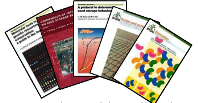 |
Please click on a topic of interest in the left hand menu.
In this section you can find manuals, handbooks and technical bulletins about germplasm (processing) and genebank management.
Some of these books discuss general genebank procedures, others show what do with the germplasm of a particular crop and finally, there are also genebank operations manuals of some CGIAR centres that might be very informative and useful for other conservation programmes.
These materials can be used by a variety of audiences including researchers, technicians and university lecturers, among others.
Methods and statistics
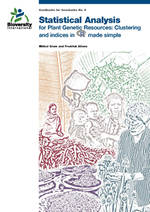 |
Handbooks for Genebanks No. 9:
Statistical analysis for plant genetic resources: clustering and indices in R made simple
This handbook aims to give researchers tools and methods to analyse mathematically complex morphological characterization data. R is a powerful software language and environment for statistical computing and graphics, developed by volunteers from around the world, working together over the Internet. The core development team consists of fewer than twenty programmers who maintain and develop the general R environment, with contributions from many others. A much larger number of contributors write individual statistical packages for R that address specific needs. Statisticians and researchers write many of these statistical packages for their own research purposes, ensuring that R is in the forefront of developments in statistics. Another of R's strengths is the ease with which well-designed publication-quality plots can be produced, including mathematical symbols and formulae where needed. On the down side, if you are used to pointand-click interfaces, you may find that R has a relatively steep learning curve. As one of the developers of R once put it, R is not designed to make easy things simple, but to make difficult things possible. Nonetheless, several projects are working on making R easier to use, and interfaces should improve in the near future. We would not propose R had we not found that it has many facilities useful to the analysis of plant genetic resources data, facilities not commonly found in other statistical packages. We also believe that with a step-by-step guide, providing examples of typical analyses required in plant genetic resources research, most researchers will be able to implement such analyses quite simply on their own data. This tutorial provides such a guide, beginning with simple examples that soon demonstrate the power of R, and allows users to gradually become acquainted with the more complex aspects. Just enough explanation of the statistics is given for readers with a basic understanding of the subject to understand the output of the analyses.
Authors: Grum, M.; Atieno, F.
Publication Year: 2007
Pages: 40
ISBN-13: 978-92-9043-735-2
Language: English
 |
IPGRI Technical Bulletin No. 4: Design and analysis of evaluation trials of genetic resources collections: A guide for genebank managers (0.2MB)
This guide is for genebank managers who are considering undertaking evaluation trials on the genetic material in their care. It covers the stages involved in an experimental programme, from the determination of the objectives of each trial to the methods used for the analyses: a broader subject area than that of 'traditional' statistics. The coverage can only give general guidelines, and managers will need to interpret and adapt them for their particular crops. This guide discusses some of the statistical issues that should be borne in mind when conducting an evaluation trial. Managers will also need to consider practical aspects of the way their crops should be grown. A compromise between statistical and practical consideration can be found. This document is intended to stimulate discussion with and among genebank managers on how they could be using their genetic materials to the fullest.
Publication Year: 2000
Pages: 53
ISBN-10: 92-9043-505-4
ISBN-13: 978-92-9043-505-1
Language: English
 |
Boletin Tecnico IPGRI No. 8: Anàlisis Estadístico de Datos de Caracterización Morfológica de Recursos Fitogenéticos (3.3MB)
Para la preparación de este boletín se tuvieron en cuenta varios Estudios de Casos en los que se incluyen como objetivos de la caracterización: (1) la medición de la variabilidad genética de la colección de germoplasma; (2) el establecimiento de la representatividad de los ejemplares en la colección en relación con la variabilidad del germoplasma en una región o con la variabilidad total de la especie involucrada; y (3) la caracterización de la estructura genética. Otros objetivos, no utilizados en los estudios de casos en este boletín, son la identificación de duplicados en una colección y la detección de genes especiales o alelos particulares, bien sea solos o en combinaciones únicas, que se expresan en caracteres morfológicos en diferentes estados.
En este boletín se hace énfasis en el análisis estadístico de los datos de caracterización morfológica como el primer paso para estudiar la variabilidad genética y se presentan, en forma general, las diferentes técnicas estadísticas que facilitan un mejor entendimiento de dicha variabilidad. Sin embargo, los editores quieren llamar la atención del investigador indicando que en la temática no se incluyen técnicas estadísticas relacionadas con la biología molecular la cual ha agregado nuevos conceptos y herramientas para un mejor entendimiento de la variabilidad y donde, igualmente, el análisis de datos juega un papel importante.
Aunque los actuales avances derivados de la biología molecular han proporcionado nuevas técnicas para la caracterización de germoplasma, la aplicación de éstas todavía no se ha generalizado en la mayoría de los bancos de germoplasma de la región. Así mismo, los desarrollos en los sistemas de información geográfica (SIG) están facilitando la identificación de las condiciones predominantes en los sitios de origen de las especies vegetales. En consecuencia, gracias a estas herramientas modernas la caracterización está tomando una nueva orientación hacia el análisis integrado que incluye varias disciplinas para una mejor comprensión de la variabilidad genética de las colecciones de germoplasma.
Se espera que las técnicas aquí descritas sean útiles para los investigadores en recursos genéticos y curadores de colecciones de germoplasma que trabajan en forma exclusiva con descriptores morfológicos.
Authors: Franco, T.L.; Hidalgo, R. (eds.)
Publication Year: 2003
Pages: 90
ISBN-10: 92-9043-543-7
ISBN-13: 978-92-9043-543-3
Language: Espanol
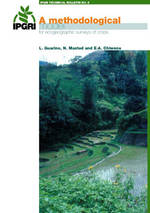 |
IPGRI Technical Bulletin No. 9: A methodological model for ecogeographic surveys of crops (1MB)
The publication is aimed at curators and other genebank staff. It is meant to be a discussion guide, to provide ideas and suggestions on how management procedures can be improved, and to point to possible implications of a given management procedure. It does not aim to provide a definitive theory on composing genebank collections or on the management of accessions, nor does it attempt to provide a complete overview of possible approaches and procedures. The reader is invited to give feedback to IPGRI (comments, additions, alternative approaches, etc.) on any aspect of the contents, and thus contribute to the discussion started with this publication.
Author: de Vicente, M.C. (ed.)
Publication Year: 2005
Pages: 55
ISBN-10: 92-9043-690-5
ISBN-13: 978-92-9043-690-4
Language: English
Practical manuals for Genebanks
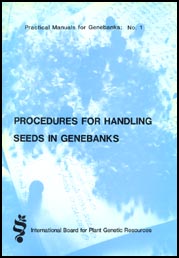 |
Practical manuals for Genebanks No. 1:
Procedures for Handling Seeds in Genebanks (An HTML version of this manual can be viewed on Bioversity's website here)
This manual is the first in a series of practical guides to suitable methods for processing and storing seeds in genebanks. It is aimed specifically at informing genebank personnel, especially those technicians and staff involved in day-to-day seed handling. (Reprinted 1988)
Authors: Hanson, J.
Publication Year: 1985
Pages: 115
Language: English
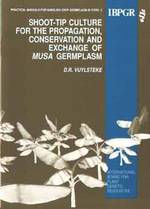 |
Practical manuals for Handling Crop Germplasm In Vitro 2:
Shoot-tip Culture for the Propagation, Conservation and Exchange of Musa Germplasm (This manual can be purchased via Bioversity's website here)
This publication reviews in detail the history of shoot-tip culture of Musa, in vitro propagation procedures, in vitro conservation, germplasm exchange using in vitro cultures and potential problems.
Authors: Vuylsteke, D.R.
Publication Year: 1989
Pages: 56
ISBN-10: 92-9043-140-7
ISBN-13: 978-92-9043-140-4
Language: English
Wild species conservation
 |
IPGRI Technical Bulletin No. 11: In situ conservation of wild plant species a critical global review of good practices (1.4MB)
The aim of this book is to provide readers with a broad understanding of the concept and methodologies of in situ conservation for target plant species. The book is based upon a global survey, undertaken by the first author, of existing guidelines, methodologies, case studies and other relevant literature on the in situ conservation of plant species, as well as current activities in this area by national and international agencies. This global review was undertaken as part of a UNEP/GEF project (EP/INT/204/GEF) entitled 'Design, Testing and Evaluation of Best Practices for in situ Conservation of Economically Important Wild Species', for which FAO was the executing agency. In preparing the review for publication as a book, we have taken the opportunity to revise the text and add further examples in order to make it suitable for the general reader interested in the subject of in situ conservation of species. We have tried to include examples from as many countries as possible, although much of the work in this area has up until now been undertaken in temperate regions. We have also provided an extensive bibliography which will allow the reader to explore many of the topics covered in the text in more depth.
This book is divided into four parts. Part I deals with the concept, approach and actors of species-based in situ conservation and attempts to clarify the ambiguity of the concept of in situ conservation as it relates to target species. In the minds of many people, in situ conservation is taken to mean the creation of protected areas and implies a narrow ecosystem approach, with the inclusion of local communities and conservation of species being incidental. This concept is now rapidly changing, as more focus is placed on individual target species and the needs and well-being of local communities and people are beginning to receive more consideration. It is also clear that in situ conservation cannot be the sole mode of conservation: it will not be possible to turn the location of every population of wild plants into a protected area, due to cost considerations or other land-use reasons. in situ conservation will need to be complemented by ex situ conservation where appropriate and, in particular, some sites will need to be managed with local stakeholders in a participative manner. Global changes in population growth, land-use patterns and climate change will also affect the ways in which in situ sites are designed and managed (see Section 1.5). This part also discusses the most important international instruments which govern the conservation of wild plant species, notably the Convention on Biological Diversity and the Global Plan of Action, as well as other regional initiatives, and the role of major UN and international agencies dealing with wild species.
Part II of the book focuses on in situ conservation methodologies and describes the various approaches of in situ conservation and the main steps needed for developing a conservation strategy for target species in situ. A number of initial steps are required before in situ conservation sites can be effectively planned and established. These include setting priorities for target species, establishing an information baseline through the carrying out of ecogeographical surveys, and estimating the amount and pattern of genetic diversity. Once this information becomes available, it is possible to prioritize conservation areas for protection and/or management. This part also describes the different types and the role of protected areas in species conservation, and discusses the conservation of species outside protected areas. Of even more importance is the management and monitoring of in situ conservation and populations: this aspect is one of the most neglected in protected areas management, as many protected areas do not have management plans or are not adequately managed, especially for target species. These issues need to be given more prominence by policy-makers.
The global survey of in situ conservation activities is described in Part III. Examples of in situ conservation of various types of taxa, such as threatened species, medicinal and aromatic species, forestry species, crop wild relatives, fruit trees and shrubs, and ornamental and other miscellaneous groups across the world are provided as illustrations of their effective conservation in situ. Detailed information about specific case studies is provided in boxes throughout the text.
Finally, Part IV offers some conclusions and recommendations.
It is hoped that this book will provide managers of protected areas, conservation officers and government officials, as well as all stakeholders involved in in situ conservation, with valuable information and an in-depth understanding of in situ conservation methodologies. It should also be a valuable guide for students of ecology and others engaged in the study of plant genetic resources.
Authors: Heywood, V.H.; Dullo, M.E.
Publication Year: 2005
Pages: 174
ISBN-10: 92-9043-698-0
ISBN-13: 978-92-9043-698-0
Language: English
More Articles...
Subcategories
-
Training modules
- Article Count:
- 13
-
Videos and slideshows
- Article Count:
- 25
-
Manuals and handbooks
- Article Count:
- 15
-
Powerpoint presentations
- Article Count:
- 3
-
Publications
- Article Count:
- 13
-
main
- Article Count:
- 7
-
Other languages
- Article Count:
- 6




